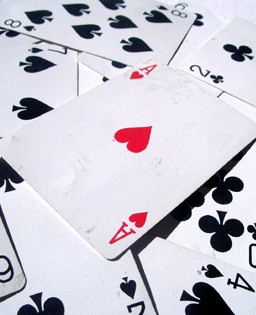
Don and his team are called to the scene of the murder of a Los Angeles gang member, but they soon learn that they are investigating the murder of another agent who had been working undercover.
Amongst other techniques, Charlie uses Probability Theory and Poisson Distributions to help better understand the L.A. gang scene.


Chance is a natural and intuitive concept, and one can easily make and understand sentences like "the chances of you running a mile in less than 20 seconds are less than those of you rolling a 7 with two ordinary dice". Probability is the branch of mathematics that makes it possible to quantify, compare and study such statments, by assigning to an event such as "flipping a coin and showing heads" a number between 0 and 1, called its probability (of occuring), where 0 means that it is (almost) impossible for the event to occur and 1 means it is (almost) certain, while 1/2 means that if you try the experiment a million times, about half of the tries will lead to a positive outcome, while the other half will lead to a negative one.

In its most basic form, to define the probability of an event, one usually proceeds as follows:

Counting occurences of rare events is a very common problem that arises in almost every branch of science. Here are but a couple of examples of such situations.
Clearly, this is a list which could be extended indefinitely. You have to think only for a moment of the applications to counting: colonies of bacteria on a dish, flaws in a carpet, bugs in a program, photons in your telescope, lighning strikes on your steeple, wasps in your beer, and so on.
In order to study the mathematics behind this problem, let us focus on one of those examples which will represent or act as a model for all the rest. Let us count the number of phone calls received by Pam, during a time period of length t, [0, t] say.
The period is divided up into n equal intervals; as we make the intervals smaller (weeks, days, seconds, ...), the number n becomes larger. We assume that the intervals are so small that the chance of two or more shootings in the same intervalis negligible.
Furthermore, different clients take no account of other clients' calendars, in the sense that it is reasonable to suppose that phone calls in different intervals are independent, and that the chance of a phone call is the same for each of the n intervals, p say. (A more advanced model would take into account the fact that phone calls sometimes come in showers.) Thus the total number of calls in the n intervals is the same as the number of successes in n Bernoulli trials, with distribution
which is binomial. These assumptions are in fact well supported by observation.
Now obviously p depends on the size of the interval; there must be more chance of a call during a month than during a second. Also it seems reasonable that if p is the chance of call in one minute, then the chance of call in two minutes should be 2p, and so on. This amounts to the assumption that n*p/t is a constant, which we call lambda. So n*p = lambda*t
Thus as we increase n and decrease p so that lambda * t is fixed, we have the following situation: *****
The important point about the aboce derivation is that it is generally applicable to many other similar circumstances. Thus, for example, we could replace 'phone calls' by 'chocalate chips' and 'the interval [0,t]' by 'a chocolate cake'; the 'n divisions of the interval' then become 'the n slices of the cake', and we may find that a chocolate cake made from a large batch of mixed dough will contain a number chocolate chips with a Poisson distribution, approximately.
The same arguments has yielded approximate Poisson distributions observed for flying bomb hits on London in 1939-45, soldiers disabled by horse-kicks in the Prussian Cavalry, accidents along a stretch of road, and so on. In general, rare events that occur independently but consistently in some region of time or spacem or both, will often follow a Poisson distribution. For this reason, it is often called the law of rare events.
Notice that we have to count events that are isolated, that is to say occur singly, because we have assumed that only one event is possible in a short enough interval. Therfore we do not expect the number of people involved in accidents at a junction to have a simple Poisson distribution, because there may be several in each vehicle. Likewise, the number of daisy flowers in your lawn may not be Poisson, because each plant has a cluster of flowers. And the number of bacteria on a Petri dish may not be Poisson, because the separate colonies form tightly groups. The colonies, however, may well have an approximate Poisson distribution.